Research Report: Loyalty Programmes Impact on Customer Retention
VerifiedAdded on 2023/05/28
|21
|5041
|313
Report
AI Summary
This research report investigates the impact of customer loyalty programs on customer retention within the UK retail sector. The study begins with an abstract summarizing the research, followed by a table of contents outlining the report's structure. The introduction establishes the problem of increasing competition and the importance of customer retention, emphasizing the role of loyalty programs. A comprehensive literature review explores existing research on customer loyalty, retention marketing, and the various types of loyalty programs, including points systems and discounts, while also considering factors like product quality and customer service. The methodology section details the research aims, objectives, philosophy, and approach, including data collection methods (surveys and interviews) and sampling strategies. The findings section presents both quantitative and qualitative analyses, followed by a discussion of the results, recommendations for retailers, and a list of references. The research suggests that while loyalty programs are important, factors such as customer service and value for money significantly impact customer retention.

Evaluating the Impact of Loyalty
Programmes on Customer Retention
Programmes on Customer Retention
Paraphrase This Document
Need a fresh take? Get an instant paraphrase of this document with our AI Paraphraser
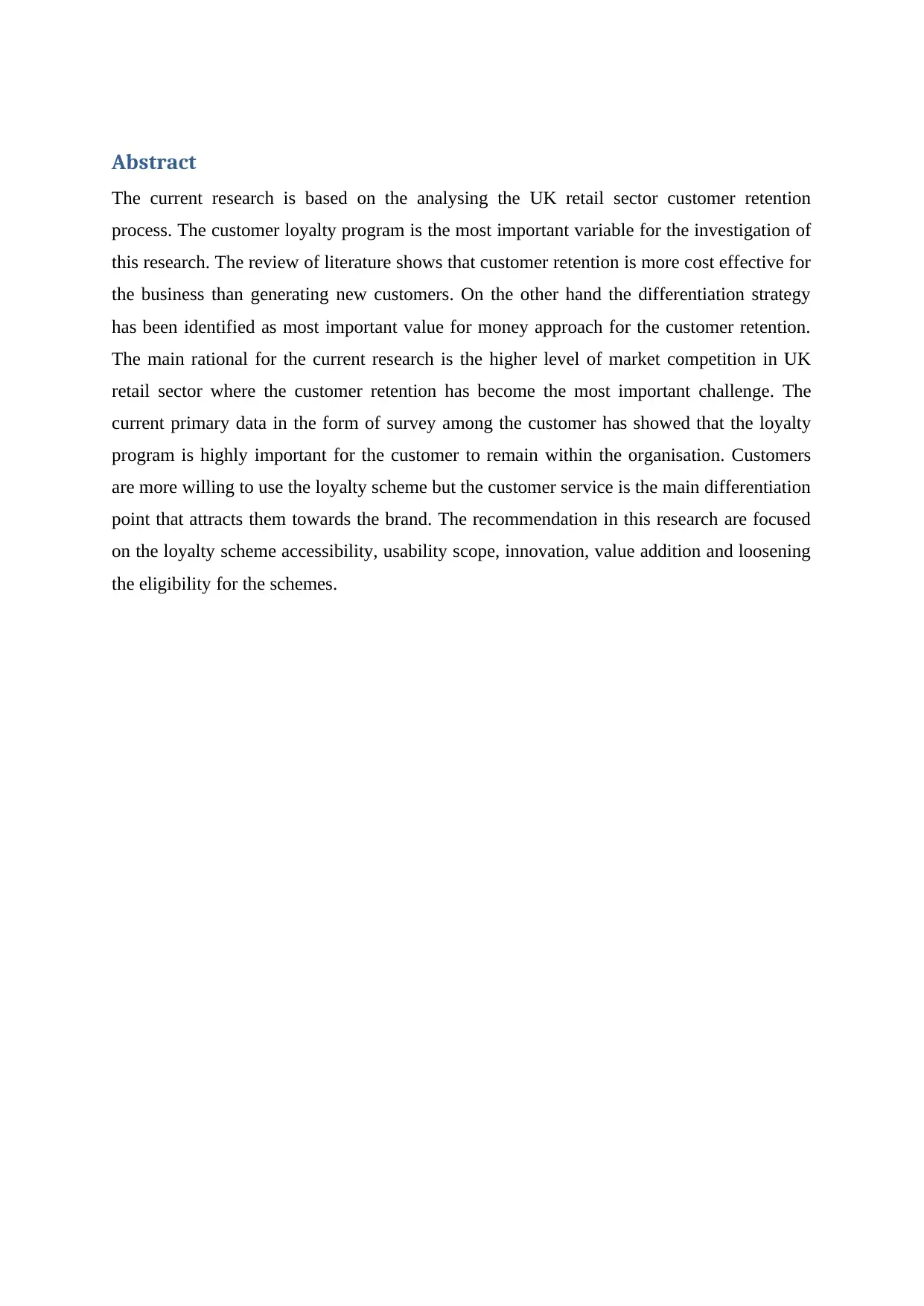
Abstract
The current research is based on the analysing the UK retail sector customer retention
process. The customer loyalty program is the most important variable for the investigation of
this research. The review of literature shows that customer retention is more cost effective for
the business than generating new customers. On the other hand the differentiation strategy
has been identified as most important value for money approach for the customer retention.
The main rational for the current research is the higher level of market competition in UK
retail sector where the customer retention has become the most important challenge. The
current primary data in the form of survey among the customer has showed that the loyalty
program is highly important for the customer to remain within the organisation. Customers
are more willing to use the loyalty scheme but the customer service is the main differentiation
point that attracts them towards the brand. The recommendation in this research are focused
on the loyalty scheme accessibility, usability scope, innovation, value addition and loosening
the eligibility for the schemes.
The current research is based on the analysing the UK retail sector customer retention
process. The customer loyalty program is the most important variable for the investigation of
this research. The review of literature shows that customer retention is more cost effective for
the business than generating new customers. On the other hand the differentiation strategy
has been identified as most important value for money approach for the customer retention.
The main rational for the current research is the higher level of market competition in UK
retail sector where the customer retention has become the most important challenge. The
current primary data in the form of survey among the customer has showed that the loyalty
program is highly important for the customer to remain within the organisation. Customers
are more willing to use the loyalty scheme but the customer service is the main differentiation
point that attracts them towards the brand. The recommendation in this research are focused
on the loyalty scheme accessibility, usability scope, innovation, value addition and loosening
the eligibility for the schemes.
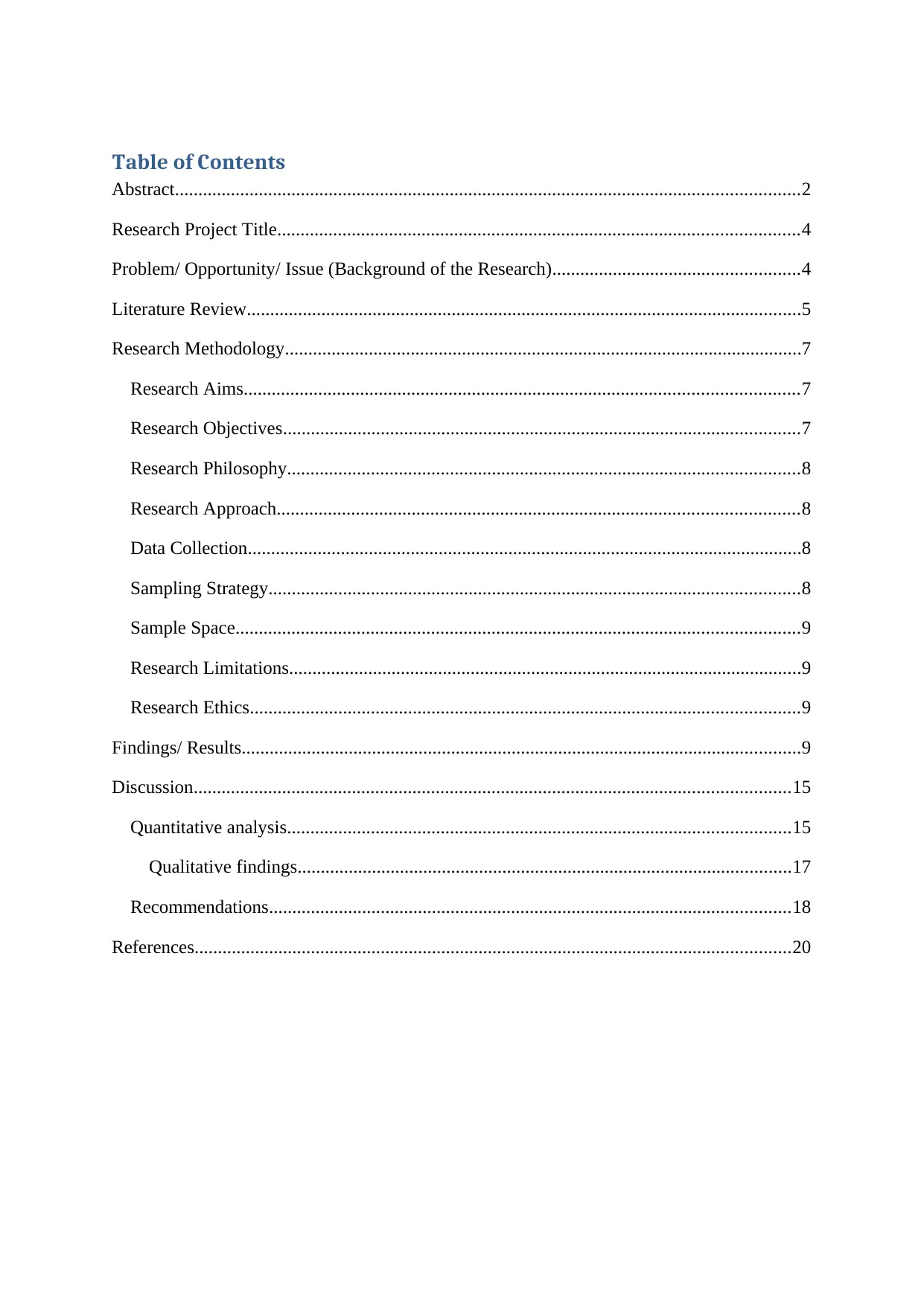
Table of Contents
Abstract......................................................................................................................................2
Research Project Title................................................................................................................4
Problem/ Opportunity/ Issue (Background of the Research).....................................................4
Literature Review.......................................................................................................................5
Research Methodology...............................................................................................................7
Research Aims.......................................................................................................................7
Research Objectives...............................................................................................................7
Research Philosophy..............................................................................................................8
Research Approach................................................................................................................8
Data Collection.......................................................................................................................8
Sampling Strategy..................................................................................................................8
Sample Space.........................................................................................................................9
Research Limitations..............................................................................................................9
Research Ethics......................................................................................................................9
Findings/ Results........................................................................................................................9
Discussion................................................................................................................................15
Quantitative analysis............................................................................................................15
Qualitative findings..........................................................................................................17
Recommendations................................................................................................................18
References................................................................................................................................20
Abstract......................................................................................................................................2
Research Project Title................................................................................................................4
Problem/ Opportunity/ Issue (Background of the Research).....................................................4
Literature Review.......................................................................................................................5
Research Methodology...............................................................................................................7
Research Aims.......................................................................................................................7
Research Objectives...............................................................................................................7
Research Philosophy..............................................................................................................8
Research Approach................................................................................................................8
Data Collection.......................................................................................................................8
Sampling Strategy..................................................................................................................8
Sample Space.........................................................................................................................9
Research Limitations..............................................................................................................9
Research Ethics......................................................................................................................9
Findings/ Results........................................................................................................................9
Discussion................................................................................................................................15
Quantitative analysis............................................................................................................15
Qualitative findings..........................................................................................................17
Recommendations................................................................................................................18
References................................................................................................................................20
⊘ This is a preview!⊘
Do you want full access?
Subscribe today to unlock all pages.

Trusted by 1+ million students worldwide
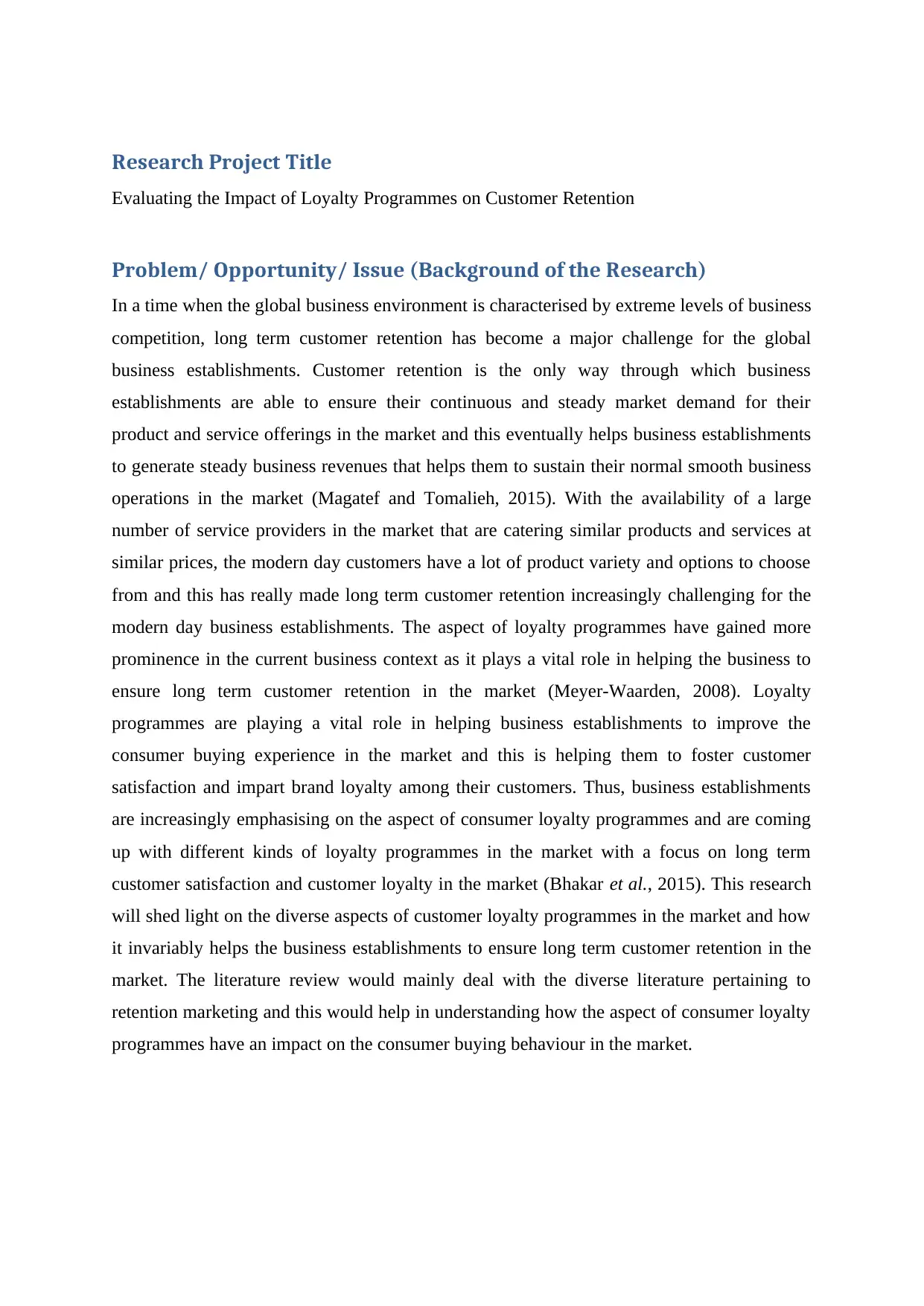
Research Project Title
Evaluating the Impact of Loyalty Programmes on Customer Retention
Problem/ Opportunity/ Issue (Background of the Research)
In a time when the global business environment is characterised by extreme levels of business
competition, long term customer retention has become a major challenge for the global
business establishments. Customer retention is the only way through which business
establishments are able to ensure their continuous and steady market demand for their
product and service offerings in the market and this eventually helps business establishments
to generate steady business revenues that helps them to sustain their normal smooth business
operations in the market (Magatef and Tomalieh, 2015). With the availability of a large
number of service providers in the market that are catering similar products and services at
similar prices, the modern day customers have a lot of product variety and options to choose
from and this has really made long term customer retention increasingly challenging for the
modern day business establishments. The aspect of loyalty programmes have gained more
prominence in the current business context as it plays a vital role in helping the business to
ensure long term customer retention in the market (Meyer-Waarden, 2008). Loyalty
programmes are playing a vital role in helping business establishments to improve the
consumer buying experience in the market and this is helping them to foster customer
satisfaction and impart brand loyalty among their customers. Thus, business establishments
are increasingly emphasising on the aspect of consumer loyalty programmes and are coming
up with different kinds of loyalty programmes in the market with a focus on long term
customer satisfaction and customer loyalty in the market (Bhakar et al., 2015). This research
will shed light on the diverse aspects of customer loyalty programmes in the market and how
it invariably helps the business establishments to ensure long term customer retention in the
market. The literature review would mainly deal with the diverse literature pertaining to
retention marketing and this would help in understanding how the aspect of consumer loyalty
programmes have an impact on the consumer buying behaviour in the market.
Evaluating the Impact of Loyalty Programmes on Customer Retention
Problem/ Opportunity/ Issue (Background of the Research)
In a time when the global business environment is characterised by extreme levels of business
competition, long term customer retention has become a major challenge for the global
business establishments. Customer retention is the only way through which business
establishments are able to ensure their continuous and steady market demand for their
product and service offerings in the market and this eventually helps business establishments
to generate steady business revenues that helps them to sustain their normal smooth business
operations in the market (Magatef and Tomalieh, 2015). With the availability of a large
number of service providers in the market that are catering similar products and services at
similar prices, the modern day customers have a lot of product variety and options to choose
from and this has really made long term customer retention increasingly challenging for the
modern day business establishments. The aspect of loyalty programmes have gained more
prominence in the current business context as it plays a vital role in helping the business to
ensure long term customer retention in the market (Meyer-Waarden, 2008). Loyalty
programmes are playing a vital role in helping business establishments to improve the
consumer buying experience in the market and this is helping them to foster customer
satisfaction and impart brand loyalty among their customers. Thus, business establishments
are increasingly emphasising on the aspect of consumer loyalty programmes and are coming
up with different kinds of loyalty programmes in the market with a focus on long term
customer satisfaction and customer loyalty in the market (Bhakar et al., 2015). This research
will shed light on the diverse aspects of customer loyalty programmes in the market and how
it invariably helps the business establishments to ensure long term customer retention in the
market. The literature review would mainly deal with the diverse literature pertaining to
retention marketing and this would help in understanding how the aspect of consumer loyalty
programmes have an impact on the consumer buying behaviour in the market.
Paraphrase This Document
Need a fresh take? Get an instant paraphrase of this document with our AI Paraphraser
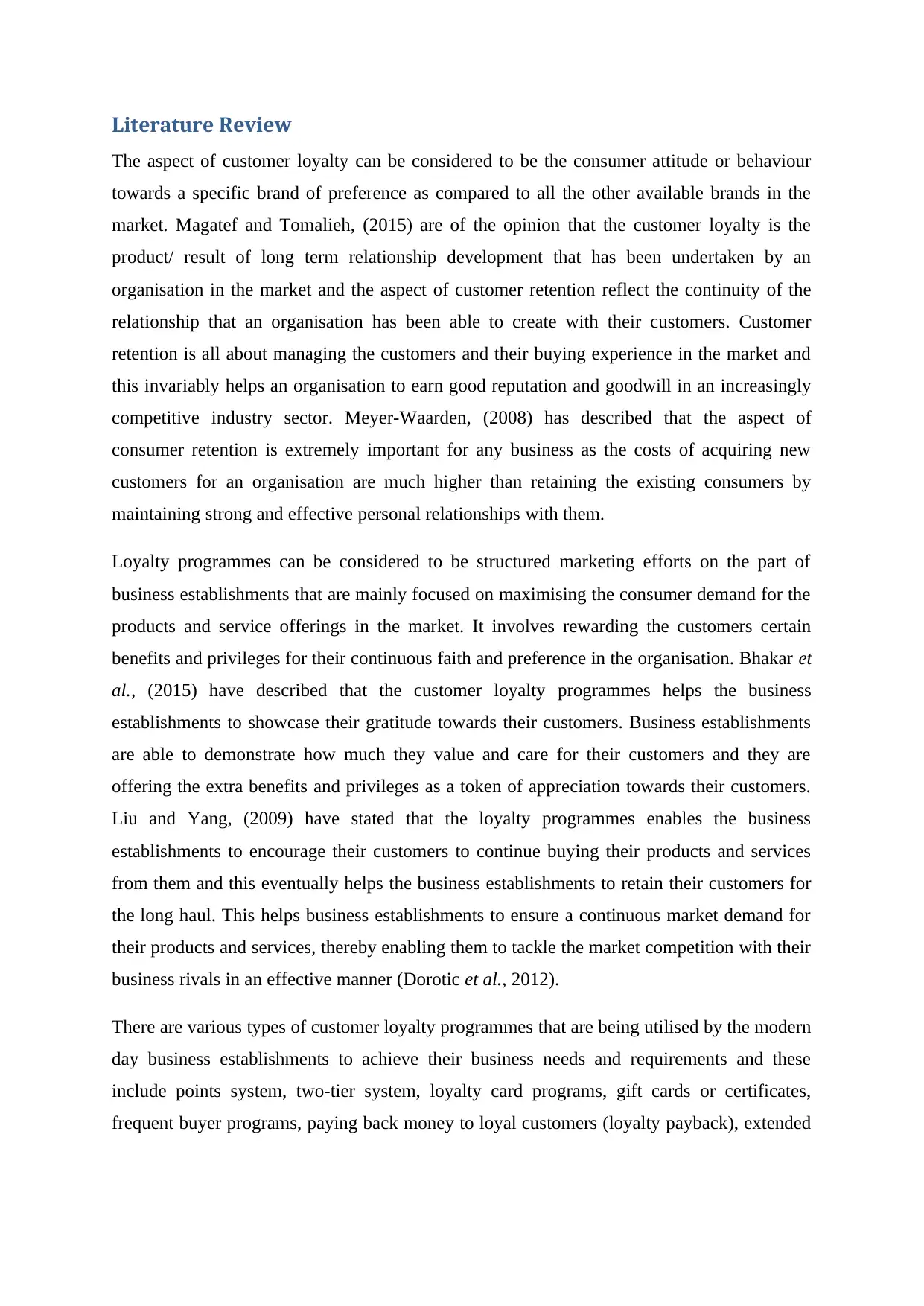
Literature Review
The aspect of customer loyalty can be considered to be the consumer attitude or behaviour
towards a specific brand of preference as compared to all the other available brands in the
market. Magatef and Tomalieh, (2015) are of the opinion that the customer loyalty is the
product/ result of long term relationship development that has been undertaken by an
organisation in the market and the aspect of customer retention reflect the continuity of the
relationship that an organisation has been able to create with their customers. Customer
retention is all about managing the customers and their buying experience in the market and
this invariably helps an organisation to earn good reputation and goodwill in an increasingly
competitive industry sector. Meyer-Waarden, (2008) has described that the aspect of
consumer retention is extremely important for any business as the costs of acquiring new
customers for an organisation are much higher than retaining the existing consumers by
maintaining strong and effective personal relationships with them.
Loyalty programmes can be considered to be structured marketing efforts on the part of
business establishments that are mainly focused on maximising the consumer demand for the
products and service offerings in the market. It involves rewarding the customers certain
benefits and privileges for their continuous faith and preference in the organisation. Bhakar et
al., (2015) have described that the customer loyalty programmes helps the business
establishments to showcase their gratitude towards their customers. Business establishments
are able to demonstrate how much they value and care for their customers and they are
offering the extra benefits and privileges as a token of appreciation towards their customers.
Liu and Yang, (2009) have stated that the loyalty programmes enables the business
establishments to encourage their customers to continue buying their products and services
from them and this eventually helps the business establishments to retain their customers for
the long haul. This helps business establishments to ensure a continuous market demand for
their products and services, thereby enabling them to tackle the market competition with their
business rivals in an effective manner (Dorotic et al., 2012).
There are various types of customer loyalty programmes that are being utilised by the modern
day business establishments to achieve their business needs and requirements and these
include points system, two-tier system, loyalty card programs, gift cards or certificates,
frequent buyer programs, paying back money to loyal customers (loyalty payback), extended
The aspect of customer loyalty can be considered to be the consumer attitude or behaviour
towards a specific brand of preference as compared to all the other available brands in the
market. Magatef and Tomalieh, (2015) are of the opinion that the customer loyalty is the
product/ result of long term relationship development that has been undertaken by an
organisation in the market and the aspect of customer retention reflect the continuity of the
relationship that an organisation has been able to create with their customers. Customer
retention is all about managing the customers and their buying experience in the market and
this invariably helps an organisation to earn good reputation and goodwill in an increasingly
competitive industry sector. Meyer-Waarden, (2008) has described that the aspect of
consumer retention is extremely important for any business as the costs of acquiring new
customers for an organisation are much higher than retaining the existing consumers by
maintaining strong and effective personal relationships with them.
Loyalty programmes can be considered to be structured marketing efforts on the part of
business establishments that are mainly focused on maximising the consumer demand for the
products and service offerings in the market. It involves rewarding the customers certain
benefits and privileges for their continuous faith and preference in the organisation. Bhakar et
al., (2015) have described that the customer loyalty programmes helps the business
establishments to showcase their gratitude towards their customers. Business establishments
are able to demonstrate how much they value and care for their customers and they are
offering the extra benefits and privileges as a token of appreciation towards their customers.
Liu and Yang, (2009) have stated that the loyalty programmes enables the business
establishments to encourage their customers to continue buying their products and services
from them and this eventually helps the business establishments to retain their customers for
the long haul. This helps business establishments to ensure a continuous market demand for
their products and services, thereby enabling them to tackle the market competition with their
business rivals in an effective manner (Dorotic et al., 2012).
There are various types of customer loyalty programmes that are being utilised by the modern
day business establishments to achieve their business needs and requirements and these
include points system, two-tier system, loyalty card programs, gift cards or certificates,
frequent buyer programs, paying back money to loyal customers (loyalty payback), extended
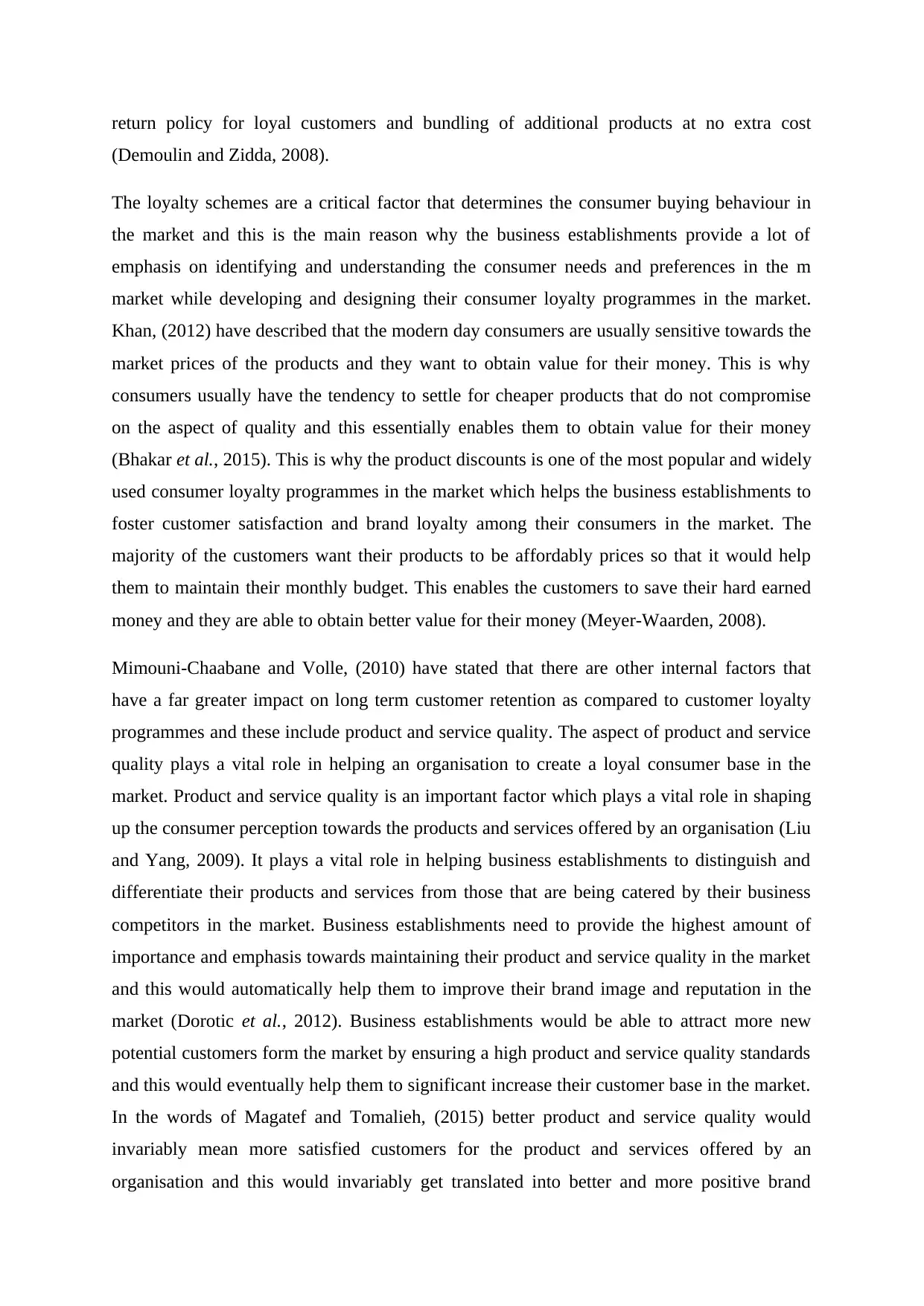
return policy for loyal customers and bundling of additional products at no extra cost
(Demoulin and Zidda, 2008).
The loyalty schemes are a critical factor that determines the consumer buying behaviour in
the market and this is the main reason why the business establishments provide a lot of
emphasis on identifying and understanding the consumer needs and preferences in the m
market while developing and designing their consumer loyalty programmes in the market.
Khan, (2012) have described that the modern day consumers are usually sensitive towards the
market prices of the products and they want to obtain value for their money. This is why
consumers usually have the tendency to settle for cheaper products that do not compromise
on the aspect of quality and this essentially enables them to obtain value for their money
(Bhakar et al., 2015). This is why the product discounts is one of the most popular and widely
used consumer loyalty programmes in the market which helps the business establishments to
foster customer satisfaction and brand loyalty among their consumers in the market. The
majority of the customers want their products to be affordably prices so that it would help
them to maintain their monthly budget. This enables the customers to save their hard earned
money and they are able to obtain better value for their money (Meyer-Waarden, 2008).
Mimouni-Chaabane and Volle, (2010) have stated that there are other internal factors that
have a far greater impact on long term customer retention as compared to customer loyalty
programmes and these include product and service quality. The aspect of product and service
quality plays a vital role in helping an organisation to create a loyal consumer base in the
market. Product and service quality is an important factor which plays a vital role in shaping
up the consumer perception towards the products and services offered by an organisation (Liu
and Yang, 2009). It plays a vital role in helping business establishments to distinguish and
differentiate their products and services from those that are being catered by their business
competitors in the market. Business establishments need to provide the highest amount of
importance and emphasis towards maintaining their product and service quality in the market
and this would automatically help them to improve their brand image and reputation in the
market (Dorotic et al., 2012). Business establishments would be able to attract more new
potential customers form the market by ensuring a high product and service quality standards
and this would eventually help them to significant increase their customer base in the market.
In the words of Magatef and Tomalieh, (2015) better product and service quality would
invariably mean more satisfied customers for the product and services offered by an
organisation and this would invariably get translated into better and more positive brand
(Demoulin and Zidda, 2008).
The loyalty schemes are a critical factor that determines the consumer buying behaviour in
the market and this is the main reason why the business establishments provide a lot of
emphasis on identifying and understanding the consumer needs and preferences in the m
market while developing and designing their consumer loyalty programmes in the market.
Khan, (2012) have described that the modern day consumers are usually sensitive towards the
market prices of the products and they want to obtain value for their money. This is why
consumers usually have the tendency to settle for cheaper products that do not compromise
on the aspect of quality and this essentially enables them to obtain value for their money
(Bhakar et al., 2015). This is why the product discounts is one of the most popular and widely
used consumer loyalty programmes in the market which helps the business establishments to
foster customer satisfaction and brand loyalty among their consumers in the market. The
majority of the customers want their products to be affordably prices so that it would help
them to maintain their monthly budget. This enables the customers to save their hard earned
money and they are able to obtain better value for their money (Meyer-Waarden, 2008).
Mimouni-Chaabane and Volle, (2010) have stated that there are other internal factors that
have a far greater impact on long term customer retention as compared to customer loyalty
programmes and these include product and service quality. The aspect of product and service
quality plays a vital role in helping an organisation to create a loyal consumer base in the
market. Product and service quality is an important factor which plays a vital role in shaping
up the consumer perception towards the products and services offered by an organisation (Liu
and Yang, 2009). It plays a vital role in helping business establishments to distinguish and
differentiate their products and services from those that are being catered by their business
competitors in the market. Business establishments need to provide the highest amount of
importance and emphasis towards maintaining their product and service quality in the market
and this would automatically help them to improve their brand image and reputation in the
market (Dorotic et al., 2012). Business establishments would be able to attract more new
potential customers form the market by ensuring a high product and service quality standards
and this would eventually help them to significant increase their customer base in the market.
In the words of Magatef and Tomalieh, (2015) better product and service quality would
invariably mean more satisfied customers for the product and services offered by an
organisation and this would invariably get translated into better and more positive brand
⊘ This is a preview!⊘
Do you want full access?
Subscribe today to unlock all pages.

Trusted by 1+ million students worldwide
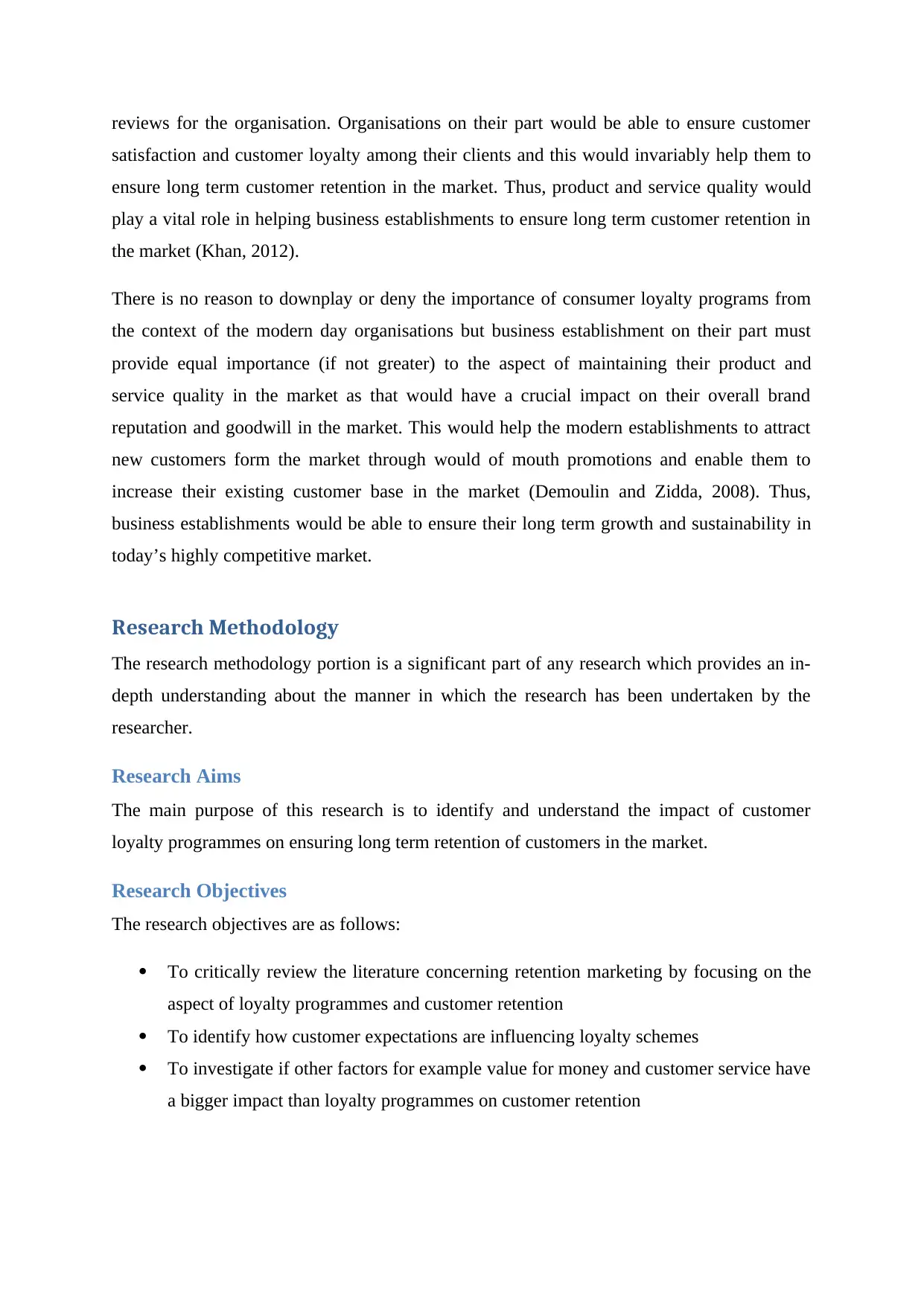
reviews for the organisation. Organisations on their part would be able to ensure customer
satisfaction and customer loyalty among their clients and this would invariably help them to
ensure long term customer retention in the market. Thus, product and service quality would
play a vital role in helping business establishments to ensure long term customer retention in
the market (Khan, 2012).
There is no reason to downplay or deny the importance of consumer loyalty programs from
the context of the modern day organisations but business establishment on their part must
provide equal importance (if not greater) to the aspect of maintaining their product and
service quality in the market as that would have a crucial impact on their overall brand
reputation and goodwill in the market. This would help the modern establishments to attract
new customers form the market through would of mouth promotions and enable them to
increase their existing customer base in the market (Demoulin and Zidda, 2008). Thus,
business establishments would be able to ensure their long term growth and sustainability in
today’s highly competitive market.
Research Methodology
The research methodology portion is a significant part of any research which provides an in-
depth understanding about the manner in which the research has been undertaken by the
researcher.
Research Aims
The main purpose of this research is to identify and understand the impact of customer
loyalty programmes on ensuring long term retention of customers in the market.
Research Objectives
The research objectives are as follows:
To critically review the literature concerning retention marketing by focusing on the
aspect of loyalty programmes and customer retention
To identify how customer expectations are influencing loyalty schemes
To investigate if other factors for example value for money and customer service have
a bigger impact than loyalty programmes on customer retention
satisfaction and customer loyalty among their clients and this would invariably help them to
ensure long term customer retention in the market. Thus, product and service quality would
play a vital role in helping business establishments to ensure long term customer retention in
the market (Khan, 2012).
There is no reason to downplay or deny the importance of consumer loyalty programs from
the context of the modern day organisations but business establishment on their part must
provide equal importance (if not greater) to the aspect of maintaining their product and
service quality in the market as that would have a crucial impact on their overall brand
reputation and goodwill in the market. This would help the modern establishments to attract
new customers form the market through would of mouth promotions and enable them to
increase their existing customer base in the market (Demoulin and Zidda, 2008). Thus,
business establishments would be able to ensure their long term growth and sustainability in
today’s highly competitive market.
Research Methodology
The research methodology portion is a significant part of any research which provides an in-
depth understanding about the manner in which the research has been undertaken by the
researcher.
Research Aims
The main purpose of this research is to identify and understand the impact of customer
loyalty programmes on ensuring long term retention of customers in the market.
Research Objectives
The research objectives are as follows:
To critically review the literature concerning retention marketing by focusing on the
aspect of loyalty programmes and customer retention
To identify how customer expectations are influencing loyalty schemes
To investigate if other factors for example value for money and customer service have
a bigger impact than loyalty programmes on customer retention
Paraphrase This Document
Need a fresh take? Get an instant paraphrase of this document with our AI Paraphraser
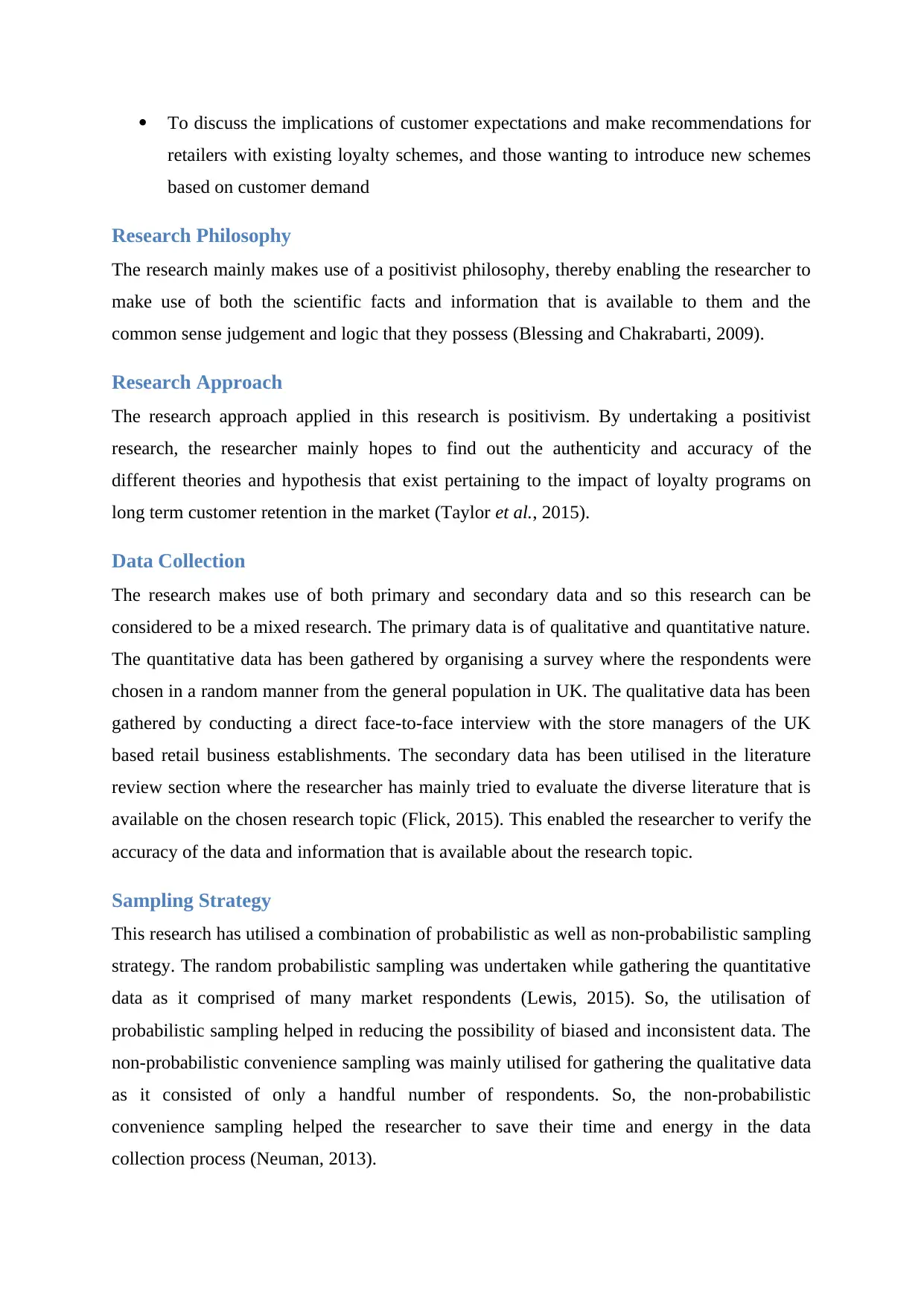
To discuss the implications of customer expectations and make recommendations for
retailers with existing loyalty schemes, and those wanting to introduce new schemes
based on customer demand
Research Philosophy
The research mainly makes use of a positivist philosophy, thereby enabling the researcher to
make use of both the scientific facts and information that is available to them and the
common sense judgement and logic that they possess (Blessing and Chakrabarti, 2009).
Research Approach
The research approach applied in this research is positivism. By undertaking a positivist
research, the researcher mainly hopes to find out the authenticity and accuracy of the
different theories and hypothesis that exist pertaining to the impact of loyalty programs on
long term customer retention in the market (Taylor et al., 2015).
Data Collection
The research makes use of both primary and secondary data and so this research can be
considered to be a mixed research. The primary data is of qualitative and quantitative nature.
The quantitative data has been gathered by organising a survey where the respondents were
chosen in a random manner from the general population in UK. The qualitative data has been
gathered by conducting a direct face-to-face interview with the store managers of the UK
based retail business establishments. The secondary data has been utilised in the literature
review section where the researcher has mainly tried to evaluate the diverse literature that is
available on the chosen research topic (Flick, 2015). This enabled the researcher to verify the
accuracy of the data and information that is available about the research topic.
Sampling Strategy
This research has utilised a combination of probabilistic as well as non-probabilistic sampling
strategy. The random probabilistic sampling was undertaken while gathering the quantitative
data as it comprised of many market respondents (Lewis, 2015). So, the utilisation of
probabilistic sampling helped in reducing the possibility of biased and inconsistent data. The
non-probabilistic convenience sampling was mainly utilised for gathering the qualitative data
as it consisted of only a handful number of respondents. So, the non-probabilistic
convenience sampling helped the researcher to save their time and energy in the data
collection process (Neuman, 2013).
retailers with existing loyalty schemes, and those wanting to introduce new schemes
based on customer demand
Research Philosophy
The research mainly makes use of a positivist philosophy, thereby enabling the researcher to
make use of both the scientific facts and information that is available to them and the
common sense judgement and logic that they possess (Blessing and Chakrabarti, 2009).
Research Approach
The research approach applied in this research is positivism. By undertaking a positivist
research, the researcher mainly hopes to find out the authenticity and accuracy of the
different theories and hypothesis that exist pertaining to the impact of loyalty programs on
long term customer retention in the market (Taylor et al., 2015).
Data Collection
The research makes use of both primary and secondary data and so this research can be
considered to be a mixed research. The primary data is of qualitative and quantitative nature.
The quantitative data has been gathered by organising a survey where the respondents were
chosen in a random manner from the general population in UK. The qualitative data has been
gathered by conducting a direct face-to-face interview with the store managers of the UK
based retail business establishments. The secondary data has been utilised in the literature
review section where the researcher has mainly tried to evaluate the diverse literature that is
available on the chosen research topic (Flick, 2015). This enabled the researcher to verify the
accuracy of the data and information that is available about the research topic.
Sampling Strategy
This research has utilised a combination of probabilistic as well as non-probabilistic sampling
strategy. The random probabilistic sampling was undertaken while gathering the quantitative
data as it comprised of many market respondents (Lewis, 2015). So, the utilisation of
probabilistic sampling helped in reducing the possibility of biased and inconsistent data. The
non-probabilistic convenience sampling was mainly utilised for gathering the qualitative data
as it consisted of only a handful number of respondents. So, the non-probabilistic
convenience sampling helped the researcher to save their time and energy in the data
collection process (Neuman, 2013).
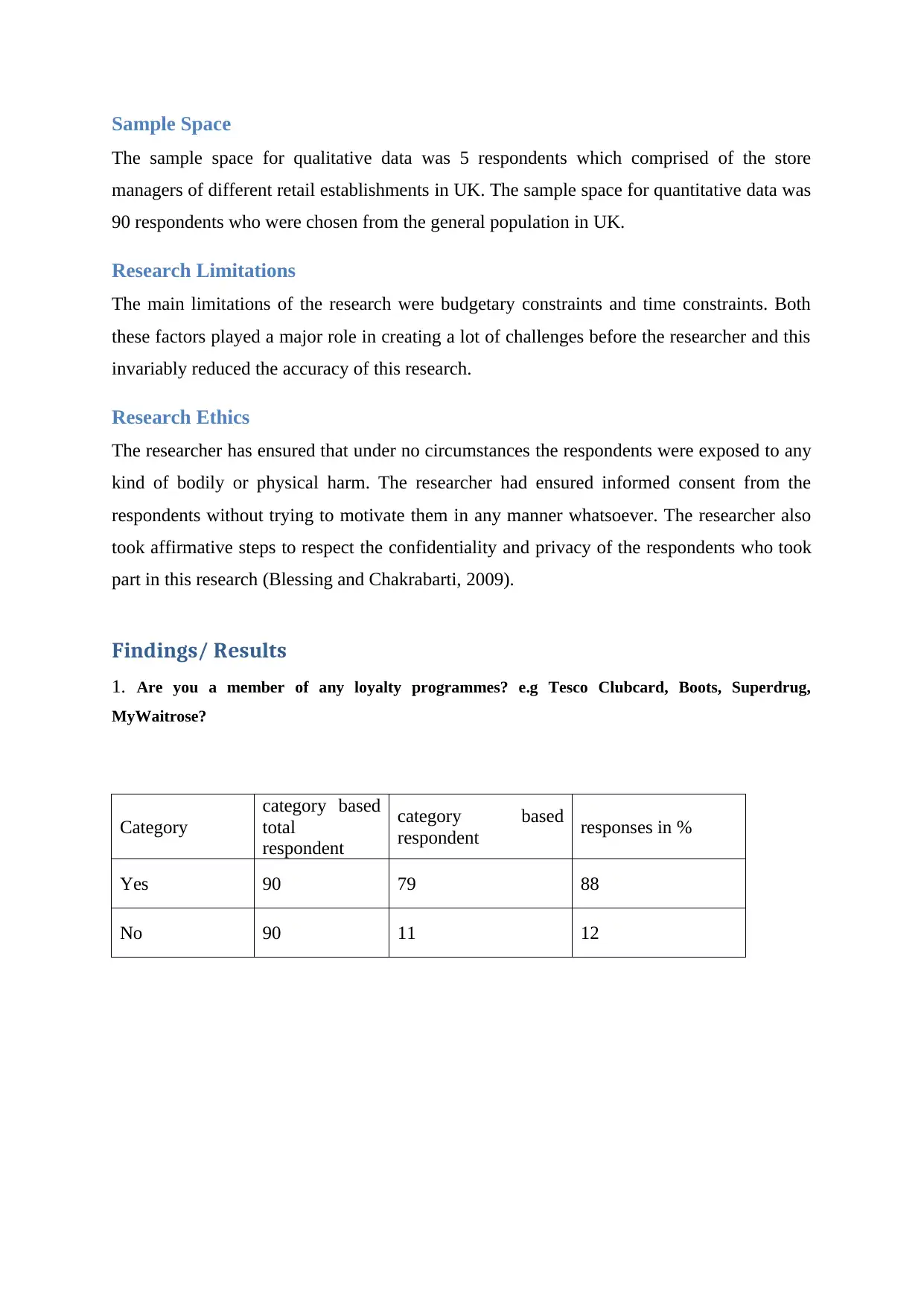
Sample Space
The sample space for qualitative data was 5 respondents which comprised of the store
managers of different retail establishments in UK. The sample space for quantitative data was
90 respondents who were chosen from the general population in UK.
Research Limitations
The main limitations of the research were budgetary constraints and time constraints. Both
these factors played a major role in creating a lot of challenges before the researcher and this
invariably reduced the accuracy of this research.
Research Ethics
The researcher has ensured that under no circumstances the respondents were exposed to any
kind of bodily or physical harm. The researcher had ensured informed consent from the
respondents without trying to motivate them in any manner whatsoever. The researcher also
took affirmative steps to respect the confidentiality and privacy of the respondents who took
part in this research (Blessing and Chakrabarti, 2009).
Findings/ Results
1. Are you a member of any loyalty programmes? e.g Tesco Clubcard, Boots, Superdrug,
MyWaitrose?
Category
category based
total
respondent
category based
respondent responses in %
Yes 90 79 88
No 90 11 12
The sample space for qualitative data was 5 respondents which comprised of the store
managers of different retail establishments in UK. The sample space for quantitative data was
90 respondents who were chosen from the general population in UK.
Research Limitations
The main limitations of the research were budgetary constraints and time constraints. Both
these factors played a major role in creating a lot of challenges before the researcher and this
invariably reduced the accuracy of this research.
Research Ethics
The researcher has ensured that under no circumstances the respondents were exposed to any
kind of bodily or physical harm. The researcher had ensured informed consent from the
respondents without trying to motivate them in any manner whatsoever. The researcher also
took affirmative steps to respect the confidentiality and privacy of the respondents who took
part in this research (Blessing and Chakrabarti, 2009).
Findings/ Results
1. Are you a member of any loyalty programmes? e.g Tesco Clubcard, Boots, Superdrug,
MyWaitrose?
Category
category based
total
respondent
category based
respondent responses in %
Yes 90 79 88
No 90 11 12
⊘ This is a preview!⊘
Do you want full access?
Subscribe today to unlock all pages.

Trusted by 1+ million students worldwide
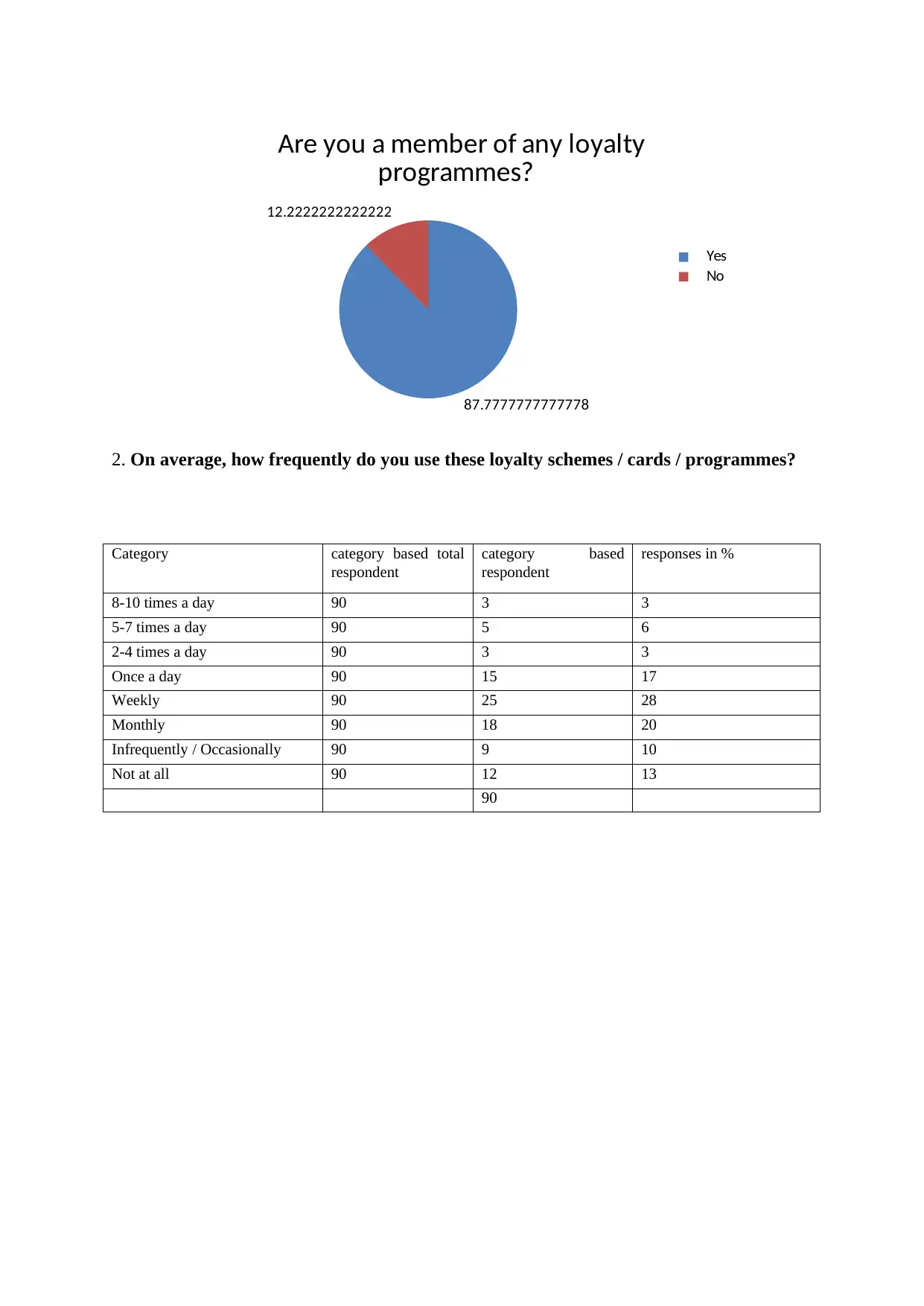
87.7777777777778
12.2222222222222
Are you a member of any loyalty
programmes?
Yes
No
2. On average, how frequently do you use these loyalty schemes / cards / programmes?
Category category based total
respondent
category based
respondent
responses in %
8-10 times a day 90 3 3
5-7 times a day 90 5 6
2-4 times a day 90 3 3
Once a day 90 15 17
Weekly 90 25 28
Monthly 90 18 20
Infrequently / Occasionally 90 9 10
Not at all 90 12 13
90
12.2222222222222
Are you a member of any loyalty
programmes?
Yes
No
2. On average, how frequently do you use these loyalty schemes / cards / programmes?
Category category based total
respondent
category based
respondent
responses in %
8-10 times a day 90 3 3
5-7 times a day 90 5 6
2-4 times a day 90 3 3
Once a day 90 15 17
Weekly 90 25 28
Monthly 90 18 20
Infrequently / Occasionally 90 9 10
Not at all 90 12 13
90
Paraphrase This Document
Need a fresh take? Get an instant paraphrase of this document with our AI Paraphraser
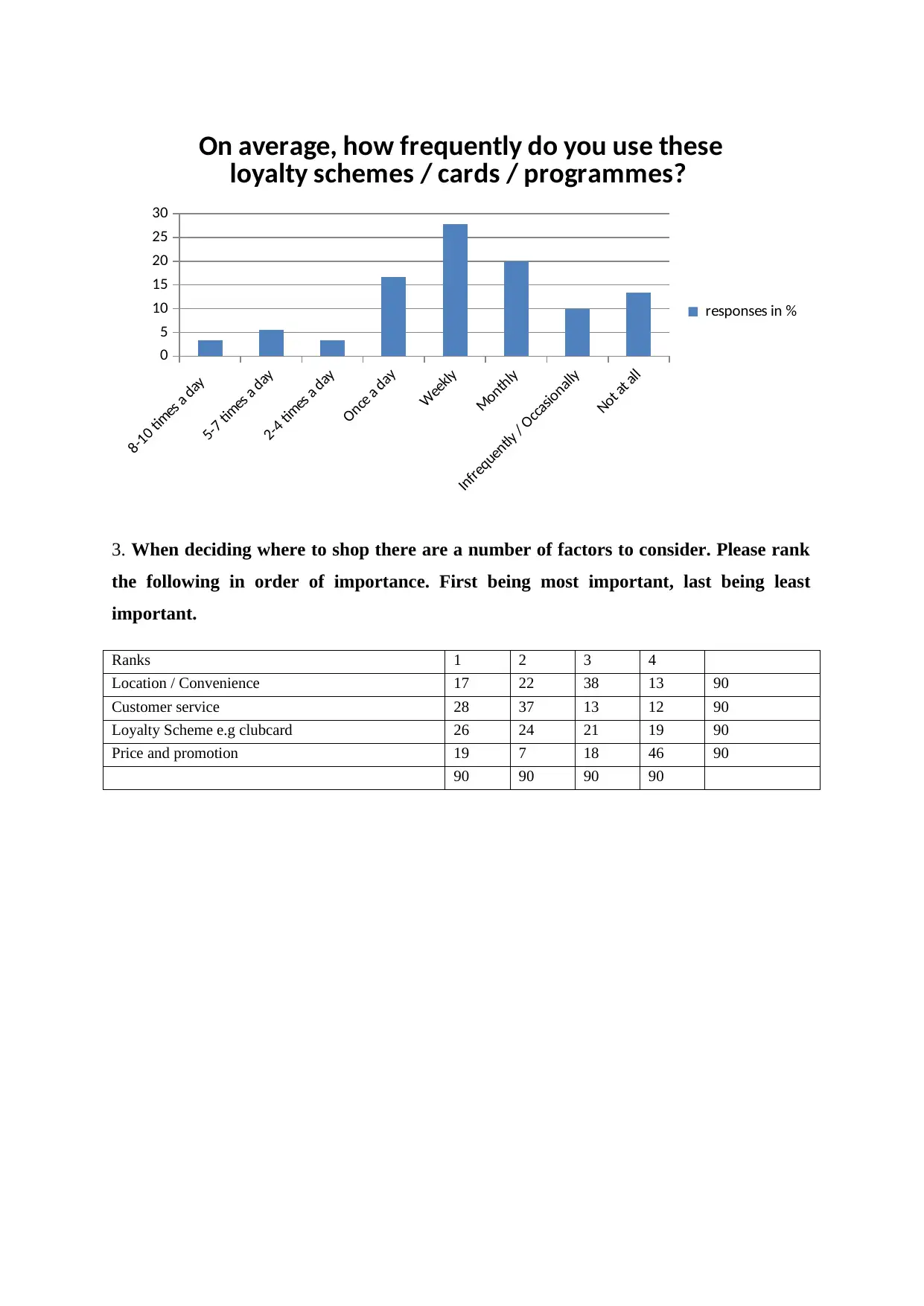
8-10 times a day
5-7 times a day
2-4 times a day
Once a day
Weekly
Monthly
Infrequently / Occasionally
Not at all
0
5
10
15
20
25
30
On average, how frequently do you use these
loyalty schemes / cards / programmes?
responses in %
3. When deciding where to shop there are a number of factors to consider. Please rank
the following in order of importance. First being most important, last being least
important.
Ranks 1 2 3 4
Location / Convenience 17 22 38 13 90
Customer service 28 37 13 12 90
Loyalty Scheme e.g clubcard 26 24 21 19 90
Price and promotion 19 7 18 46 90
90 90 90 90
5-7 times a day
2-4 times a day
Once a day
Weekly
Monthly
Infrequently / Occasionally
Not at all
0
5
10
15
20
25
30
On average, how frequently do you use these
loyalty schemes / cards / programmes?
responses in %
3. When deciding where to shop there are a number of factors to consider. Please rank
the following in order of importance. First being most important, last being least
important.
Ranks 1 2 3 4
Location / Convenience 17 22 38 13 90
Customer service 28 37 13 12 90
Loyalty Scheme e.g clubcard 26 24 21 19 90
Price and promotion 19 7 18 46 90
90 90 90 90
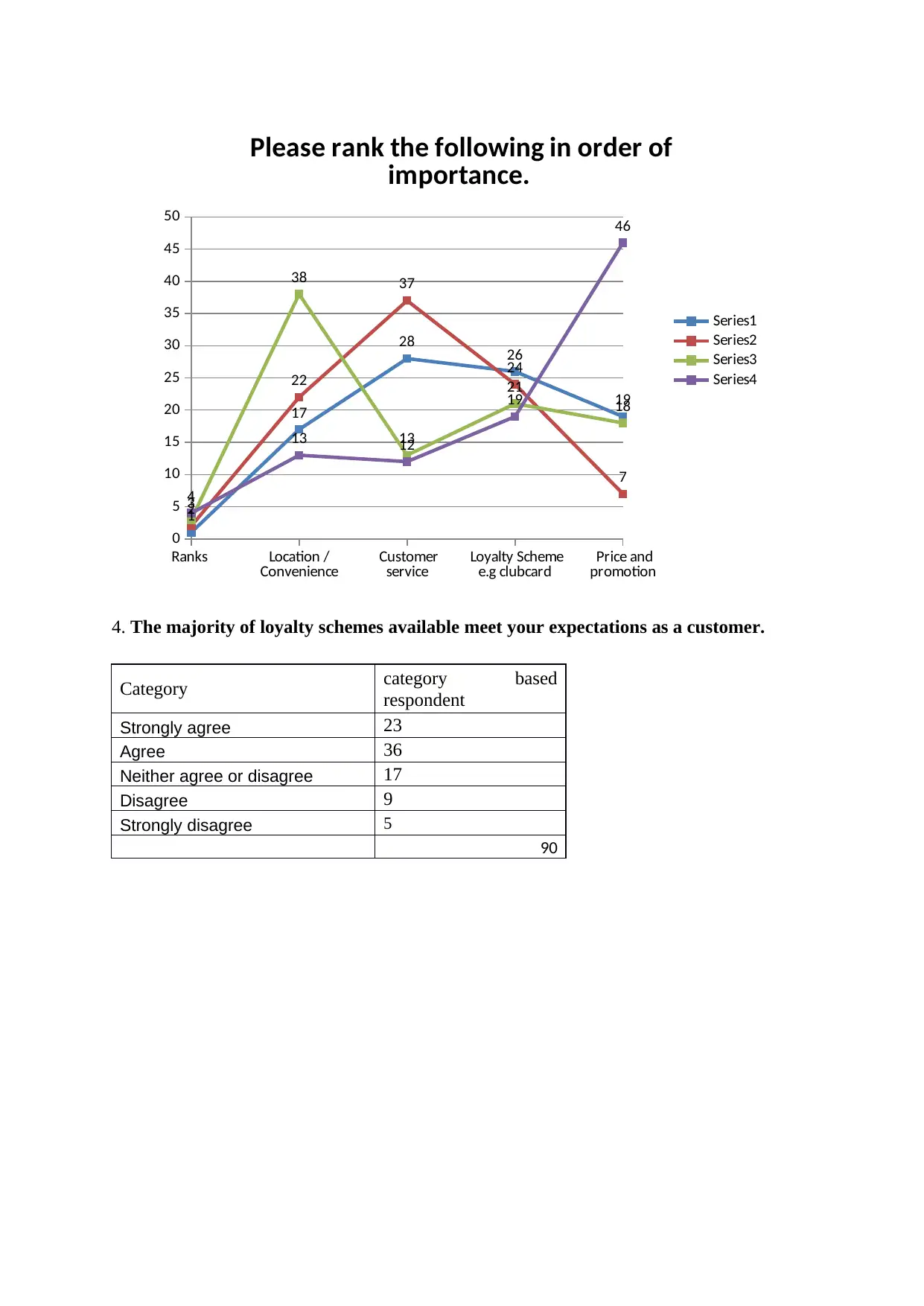
Ranks Location /
Convenience Customer
service Loyalty Scheme
e.g clubcard Price and
promotion
0
5
10
15
20
25
30
35
40
45
50
1
17
28 26
19
2
22
37
24
7
3
38
13
21
18
4
13 12
19
46
Please rank the following in order of
importance.
Series1
Series2
Series3
Series4
4. The majority of loyalty schemes available meet your expectations as a customer.
Category category based
respondent
Strongly agree 23
Agree 36
Neither agree or disagree 17
Disagree 9
Strongly disagree 5
90
Convenience Customer
service Loyalty Scheme
e.g clubcard Price and
promotion
0
5
10
15
20
25
30
35
40
45
50
1
17
28 26
19
2
22
37
24
7
3
38
13
21
18
4
13 12
19
46
Please rank the following in order of
importance.
Series1
Series2
Series3
Series4
4. The majority of loyalty schemes available meet your expectations as a customer.
Category category based
respondent
Strongly agree 23
Agree 36
Neither agree or disagree 17
Disagree 9
Strongly disagree 5
90
⊘ This is a preview!⊘
Do you want full access?
Subscribe today to unlock all pages.

Trusted by 1+ million students worldwide
1 out of 21
Related Documents
Your All-in-One AI-Powered Toolkit for Academic Success.
+13062052269
info@desklib.com
Available 24*7 on WhatsApp / Email
![[object Object]](/_next/static/media/star-bottom.7253800d.svg)
Unlock your academic potential
Copyright © 2020–2025 A2Z Services. All Rights Reserved. Developed and managed by ZUCOL.





